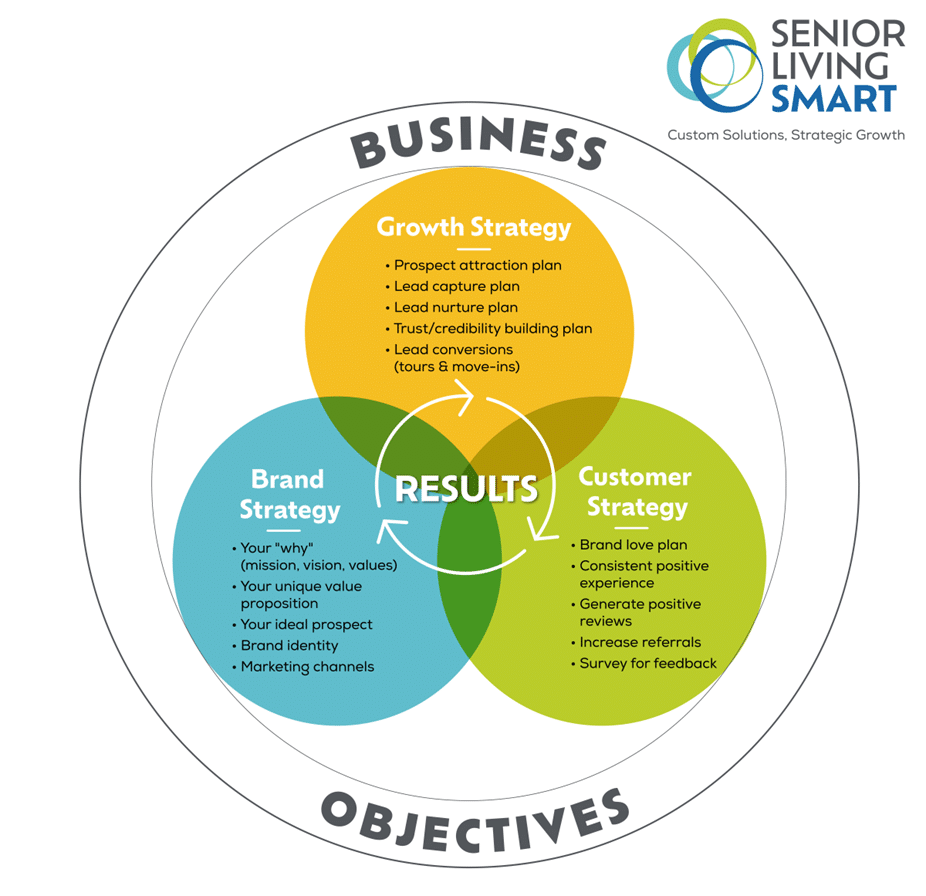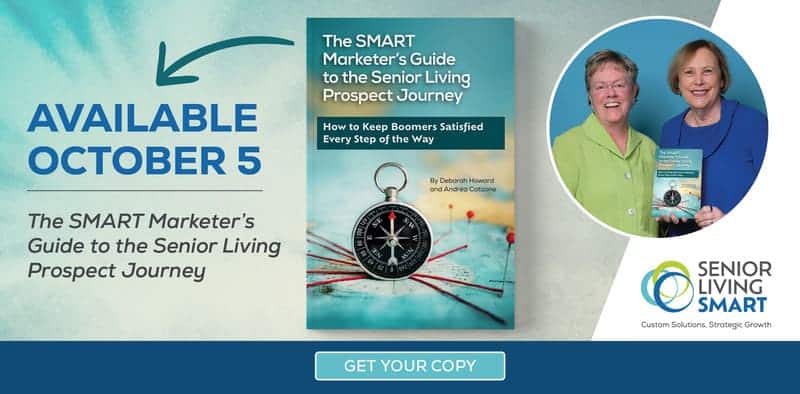Best Practices for Building Brand Recognition as a Senior Living Provider
Brand recognition is a critical component of success in the senior living industry. With increased competition and evolving consumer expectations, providers must proactively build a strong, trustworthy brand that resonates with seniors and their families.
Often, despite best intentions and efforts, searching for a senior living community for yourself or your loved one can seem like wading through a sea of sameness. Even when the amenities, activities, and physical plant vary at the communities you’re considering, the same messaging comes through for each. Building a strong brand means standing apart from the crowd and having your messaging, marketing, and operations in alignment.
Here are the best practices for improving brand recognition and establishing a compelling presence in the market.
1. Develop a Strong Brand Identity Internally
Your brand identity is the foundation of recognition and trust in your market. Having internal alignment on the following pieces will allow you to stand out in a crowded marketplace:
- Define Your Mission and Values: Clearly articulate what makes your community unique and how you serve seniors. To understand these values, connect with your stakeholders. Ask your founders and c-suite what their true “why” is. Senior living is not an easy vertical to operate in. People don’t dive into opening, owning, or operating a senior living community without a vision or a compelling reason. Interview your long-term staff and uncover their opinions on what sets you, their employer, apart. And perhaps most importantly, ask your residents and families – why did you choose us? And why do you continue to choose us month after month? The answers to these questions will help you see the true values that your organization embodies.
- Create a Consistent Visual Identity: Use a cohesive logo, color palette, and typography across all marketing materials. Your brand creatives should reflect your unique value proposition and give your audience an immediate sense of who you are. Consider getting feedback from your residents and families as you choose your visual identity.
- Develop a Unique Brand Voice: Ensure your messaging is consistent and reflects your organization’s personality and core values. In this effort, documentation is paramount. Assuring that your brand voice and visual identity are aligned, and accessible to your staff will help keep your brand consistent and recognizable. A brand style guide including fonts, colors, logo versions, visual elements (iconography, textures, etc.), and notes on usage will help keep your branding on point.
2. Optimize Your Online Presence
A well-optimized digital footprint increases visibility and trust with your prospects. Creating and building up a strong digital footprint is a long game. It will take a long-term commitment and a strategic approach. Focusing on the following best practices will give you a leg up:
- Maintain an SEO-Optimized Website: Ensure your website is user-friendly, mobile-responsive, and optimized for local search keywords like “senior living near me.” A well-structured website should include clear calls to action (CTAs), easy navigation, and accessible information about services, pricing, and amenities. In today’s environment of SEO, connecting with your audience with authentic content that answers their questions is the most important thing you can do.
- Claim and Optimize Google Business Profiles: Keep listings updated with accurate contact details, high-quality images, and positive resident testimonials. Add virtual tours and Q&A sections to engage visitors. Google Business Profile optimization is the single biggest factor impacting your local SEO authority and appearance in Google’s “map pack” of results.
- Claim and Optimize Directory Citations: Assure that online directories and citations pages, especially those geared toward the senior living industry, are claimed and accurate. Making sure your name, address, and phone number (NAP) are accurate and formatted correctly is the best first step with online citation sites.
- Encourage Online Reviews: Positive Google and Facebook reviews enhance credibility and search rankings (especially local search). Develop a system to request and manage reviews from happy residents and families, on autopilot. Be sure that you are following up and responding to reviews – good or bad – to highlight your accountability and connection with your residents and families.
- Invest in Local SEO: Optimize for location-based searches by ensuring consistency in your name, address, and phone number (NAP) across directories and using geo-targeted keywords in content. Beyond optimizing your Google Business Profile and generating positive reviews, consistency across directories and well-optimized website content will boost your local SEO results substantially. Consider building pillar pages that speak directly of the benefits of retiring in your local community or neighborhood.
- Leverage Paid Search Ads: Utilize Google Ads and social media advertising to increase visibility for high-intent keywords, targeting families researching senior living options. Aligning your ad creatives with your brand and visual identity will help keep you top of mind while your prospects are searching, further solidifying your brand recognition across channels.
3. Create Valuable Content
Content marketing is a powerful tool for building brand awareness and engagement. It influences user experience, search engine optimization, and highlights your experience in the industry. Strategies for success with senior living content marketing include:
- Educational Blog Posts: Provide insights on topics like aging, senior care trends, and financial planning for senior living. Creating an authentic and authoritative voice for your blog posts is going to help your prospects understand who you are as a brand. Aligning your content with the conversations that your sales teams are having with prospects is a great way to maintain authenticity and relevance. These posts should always strive to be genuinely helpful to your audience – not “salesy” — while reflecting the brand voice outlined in your brand style guide.
- Local Area Pillar Pages: Create targeted, content-rich pages to highlight your local area. These pages help with local SEO and also help to set your brand apart with hyper-local content that your competitors won’t be featuring. Your locality can be a vital part of your brand.
- Resident Stories and Testimonials: Humanize your brand with real-life success stories. These stories are truly one-of-a-kind and apply only to your brand. They speak powerfully to your prospects because they are authentic and unfiltered. Content generated by your residents tends to resonate well with prospects because they can see themselves reflected back at them, rather than feeling like they are being “sold” to by community staff.
- Video Marketing: Virtual tours, resident interviews, and staff spotlights help create an emotional connection while building authority for your website domain as well. Video content is becoming a must for building brand recognition and trust with your audience. It’s perceived as more natural, more authentic, and less curated. It’s harder to “hide” things when you have a robust video marketing library, from the prospect perspective.
4. Leverage Social Media Effectively
Social media is essential for engaging with prospects and families. Social media is often perceived as more natural and authentic than website content, because it is more immediate and seemingly less curated. Prospects view your social pages to get an unfiltered glimpse inside the community, to see a bit of the day-to-day experience. Key strategies for successful senior living social media marketing include:
- Consistent Posting Schedule: Share valuable content, community events, and resident stories regularly. Striving to post everyday helps keep your content in front of your audience and builds trust with your prospects. They can see inside the community and understand the benefits of living there on a day-to-day basis. The authenticity and transparency is appreciated.
- Engage with Your Audience: Respond to comments, answer questions, and participate in discussions. Connecting with your audience helps the social media algorithms highlight your content to a wider group of people, but it also showcases the human side of your organization and shows that you put care into all of your interactions, no matter how “small” they may seem.
- Use Paid Advertising: Targeted Facebook and Instagram ads help expand reach and attract qualified leads. Highlighting photography and videography from inside your communities in paid advertising is a great way to spread your brand message and increase recognition in the area.
5. Strengthen Community Engagement
Being active in the local community enhances trust and brand reputation (not to mention, it can be a great source of new referral leads). Best practices include:
- Partner with Local Organizations: Collaborate with hospitals, senior centers, and local businesses. Rehab facilities, community centers and groups (Elks, VFW, Rotary International), and your local chamber of commerce are also great options for networking and partnering. Show up authentically with the goal of adding value to these organizations – not extracting it.
- Host Educational Events: Offer seminars on topics like dementia care, financial planning, and wellness. Working with local businesses or community attractions like libraries and museums can be a great way to jump-start your event series. Working with experts in the industry can expand your network and also lend more credibility to your organization.
- Participate in Senior Living Expos: Showcase your community at industry events and local fairs. The best compliment you can get when it comes to building brand recognition for senior living is… “We see you everywhere!” Showing up in person to these types of events is a great way to garner that response.
6. Invest in Public Relations & Thought Leadership
Establishing authority in the senior living industry builds brand credibility. Ways to achieve this include:
- Contribute to Industry Publications: Submit articles or guest posts on leading senior living websites, newsletters, podcasts, and publications. Senior Housing News, Senior Housing Business, McKnight’s, AARP, and more are constantly churning out valuable content for this market. They also have already garnered enormous audiences. Leveraging their media prowess can do wonders for your own presence and credibility.
- Engage in Local Media Outreach: Position your leadership team as experts by securing press coverage. This works in tandem with hosting informative events and engaging on social media. Your team should always come across as being the resources and the experts when it comes to aging in your local area.
- Speak at Conferences and Webinars: Present insights on senior care trends and best practices. Document your successes and submit your findings to industry conferences, summits, panel discussions, podcasts and webinars. First-hand industry research is incredibly valuable to many of these organizations – being able to speak on trends you are seeing day-to-day is highly desirable content that can be extrapolated from for other providers.
7. Utilize Marketing Automation & CRM Tools
Automation and personalization enhance brand recognition by improving lead nurturing and communication. Consider:
- Automated Email Campaigns: Send targeted emails based on user behavior and interests. Following up with leads contextually, rather than generally, shows that you have deep knowledge of senior living and that you actually care about where your prospect is in their journey. Expertise and passion go a long way toward creating a favorable brand.
- Personalized Follow-Ups: Use CRM data to customize interactions with prospects. This goes beyond including someone’s name in an email – by segmenting users based on their behaviors, you can truly align your content creation with their journey and their pain points.
- Chatbots and AI-Driven Assistance: Provide instant responses to inquiries on your website by leveraging machine learning, chatbots, and AI. This allows prospects to get the information they want faster and removes that burden from your sales team – allowing for more productive and informed sales conversations.
8. Monitor and Measure Brand Performance
To ensure continued success, track key metrics such as:
- Website Traffic and Engagement: Use Google Analytics to assess visitor behavior. Are metrics like engaged sessions, pageviews per session, and time on page improving? Direct traffic should also see improvements as additional prospects become familiar with your brand and online presence.
- Social Media Insights: Analyze follower growth, post engagement, and ad performance across social media channels.
- Lead Conversion Rates: Measure the effectiveness of marketing campaigns and outreach efforts by measuring the change in lead conversion rates over time. If you’re connecting with the right audience and they are finding the information they need within your site, your conversion rates should increase as they download new information and get in touch with your sales team.
Conclusion
Building strong brand recognition as a senior living provider requires a multi-faceted approach that includes consistent branding, digital presence, valuable content, and community engagement. By implementing these best practices, you can establish trust, increase visibility, and attract more residents to your community.
Need help enhancing your senior living brand? Contact our team of experts to develop a customized marketing strategy that elevates your presence in the industry!















